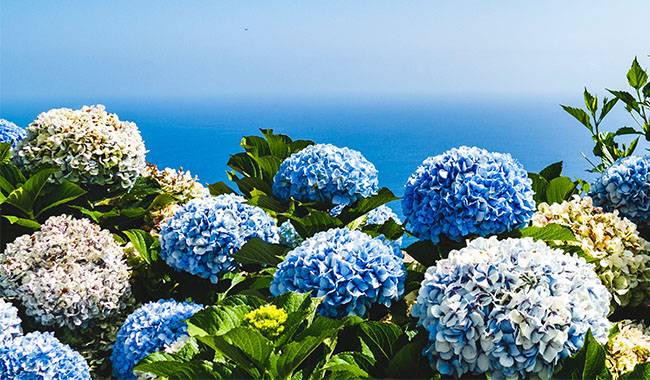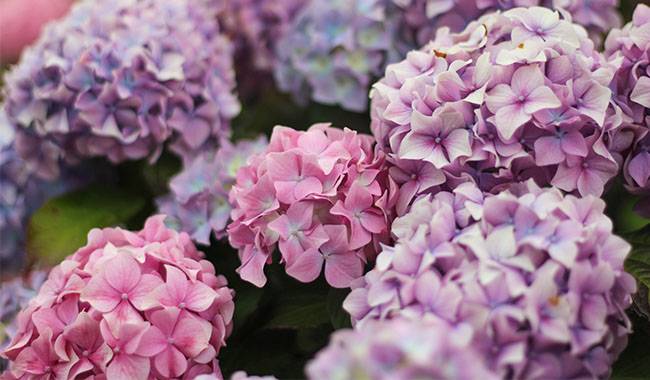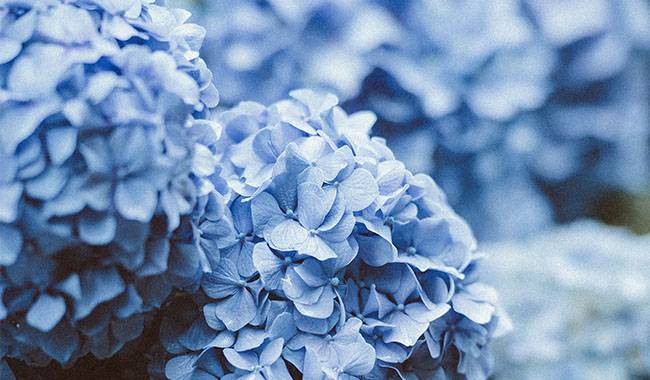
Luxurious, pink Hydrangea are equally impressive on garden shrubs as they are on smaller potted plants. Hydrangea’s flowers are a great asset – regardless of their cultivated form. While their green color itself is irresistible, it does not make them stand out. In addition, Hydrangea drops its leaves in winter. These water-loving beauties with their special “elite” status also grow well in the home. Although they require very careful temperature control and are often very demanding, they have few rivals. You will learn How to Take Care of Hydrangea Plant at Home in the ThumbGarden article.
WHAT IS HYDRANGEA?
Originating in the mild subtropical climate of China, the beautiful Hydrangea has long been a favorite of gardeners. But Hydrangea is also valuable for floral arrangements and as live bouquets for potted plants. In the latter case, they are used not only for garden decoration but also as houseplants. Indeed, only one species can be called a houseplant; the globular Hydrangea.
Hydrangea is rarely referred to by their scientific name Hydrangea or Hydrangea macrophylla (French hydrangea), although they are familiar to any gardener. These members of the family of the same name (Hydrangea family) are large deciduous shrubs that are much smaller in size in the room.
Hydrangea has large, light-colored leaves with a soft grass-green hue. They sit in an orderly pattern on the shoots. Their ovate shape and beautiful pointed tips only emphasize their thinness, beautiful matte texture, and ability to shine in the sun.
When properly cared for, the bush appears dense, although Hydrangea certainly does not have the feel of bushy foliage. With foliage ranging in size from 4-6 inches (10 to 15 cm), Hydrangea lives up to its name.
The natural height of Hydrangea indoors is 40-60 inches (1 to 1.5 m). However, the plants are kept more compact due to treatment with inhibitors or proper shaping in the center of the flowers.
THE UNIQUE FLOWERS OF THE INDOOR HYDRANGEA PLANT
The flowering time of indoor Hydrangea is different from that of Hydrangea in the garden. Unlike the midsummer garden beauty, the large-leaved indoor Hydrangea starts its procession in February and March and finishes blooming in July. Plants can be cultivated for sale at other times of the year. By changing the time of rest, you can also regulate flowering at home.
The inflorescence shape of indoor Hydrangea can vary considerably, even for the same species. Some varieties have perfect globular inflorescences, some hydrangeas have flat tops, and others have layered shrouds. They also vary in flower density and inflorescence size – from 2 inches (5 cm) in the petite varieties to 8 inches (20 cm) in the classic shades.
In the inflorescence, the large sterile flowers are arranged at the edges as if clustered on the fruiting flowers, but in the cultivars, where the shields appear solid, this difference is not as pronounced.
Hydrangea itself is not very showy. Hydrangea is miniature, as small beads, with a background of brighter, diamond-shaped, flattened, brightly colored bracts. hydrangea, with four petals, looks almost paper-like.
The palette of indoor Hydrangea is somewhat broader than that of the large-leaved Hydrangea in the garden. This is because, in floral centers, various means are used to intensify and change the colors through artificial color treatments. Thanks to them, the shrubs on the counter can surprise with bright blue, lettuce, or even yellow colors. But this unnatural beauty does not last long and is unlikely to last into the next year.
The natural range of indoor Hydrangea includes whites, pinks, purples, and blues, with the softest, most muted variations.
VARIETIES OF HYDRANGEA PLANTS INDOORS
It is better to choose indoor Hydrangea based on the size and color of the plant, rather than on the name of the variety. You will find the most colorful and extravagant monochromatic versions, as well as fascinating watercolor, irregularly colored cultivars.
A truly classic variety for indoor cultivation has always been.
Compacta is a low-growing variety with very bright, densely arranged foliage and balloon-like inflorescences that can change to watercolor-like shades of pink.
Blushing Bride is a beautiful variety with delicate cream-colored flowers and dark foliage, well-branched and of medium height.
Ramars Mars is a compact, low-growing variety with a very unusual lavender-blue inflorescence that shifts from soft salad color to blue to lavender, darkening with time.
Early Blue is a very pretty variety with lettuce inflorescences that gradually turn blue.
Early Blue – A variety with globular inflorescences that, under the right conditions, can take on an amethyst-like deep blue color. The bush is very spreading and often droops to one side.
One of the most beautiful blue-violet varieties of Nikko Blue, with watercolor-like irregularly colored flowers and very dark, bright green, heart-shaped, wrinkled leaves.
Madame Emile Mouillere – An unusual narrow-leaved variety with three rows of “petals” and a blue swell in the center.
Soeur Therese is an elegant white variety with pale lavender and sky blue ballooning florets.
Red Link – A warm pink dwarf variety with freshly opened flowers with a pale yellow center, which appears more delicate due to the slightly loose structure of the inflorescence.
Magent – A bright pink, deep red Hydrangea with large 12 inches (30 cm) inflorescences that have an unusual cut “petal” margin. The shrub is very strong, about 30 inches (75 cm) tall.
Red Sensation – A burgundy, deep red variety that turns wine and purple when grown in acidic soil. The very bright green color and finer foliage create a curling effect.
Prime – An attractive pink Hydrangea with buds the color of the original yellow. The flattened inflorescence resembles a solid shield, resting on a cushion of very short stems and frosted dark green leaves. Maximum height – about 10 inches (25 cm).
GROWING CONDITIONS FOR INDOOR HYDRANGEA PLANTS

The key to keeping Hydrangea alive and flowering for a long time remains proper lighting and temperature. They do not adapt well to new locations and prefer a stable environment.
Lighting and placement
Hydrangea, even indoors, can be grown in bright places as well as semi-shady locations. Hydrangea cannot tolerate strong shade, of course, but diffuse light is comfortable for them.
Most Hydrangea that does not form dwarfs will not adapt well to window sills over time. They can be placed either on furniture or on the floor near a window. The shrubs do not tolerate direct sunlight, which quickly leads to the loss of small ornamental flowers and foliage.
During flowering, it is best to ensure that the light remains soft and constant and that Hydrangea does not change its orientation to the window: turning, moving, or walking around can stress the plant and cause it to flower more quickly.
Lighting is important for Hydrangea during rest periods, but in a different way than for ordinary houseplants: Hydrangea needs to be dimmed, or a shrub cover placed over it to protect it from light. However, this is only the case after the leaves have fallen off.” Do not expose bare Hydrangea to light until the buds begin to swell.
Indoor Hydrangea is the plants that overwhelm their neighbors. They are so large and attractive that there are few houseplants next to which they cannot lose their charm.
But negative effects are not uncommon: next to crops with shiny, leathery leaves and perfect shapes, Hydrangea can look rather unkempt and lose some of their aristocratic charms. Therefore, you are better off displaying them as living single bouquets, beautiful single decorations. Except, of course, in the company of other Hydrangea.
Temperature control and ventilation
Hydrangea is less resistant to temperature when moved to indoor living areas. They need mild conditions and a steady cool temperature reminiscent of the comfort of the shade of a garden tree.
Hydrangea looks to develop and blooms best when maintained at moderate room temperatures of no more than 68 °F (20°C) between March and October. 64-68 °F (18-20°C) is the best range. The higher the temperature, the faster Hydrangea will bloom and the less the leaves will open.
Hydrangea should spend its resting period in cooler conditions. The maximum allowable temperature for overwintering is plus 50 °F (10 °C). The optimum – about 41 °F (5 °C). Hydrangea can flower only after wintering at low temperatures, and the quality of its flowering depends on comfortable and stable temperatures.
Find a suitable place for indoor Hydrangea in winter, such as a cellar, wine cellar, cold greenhouse, between frames, or in a cold foyer.
Hydrangea, being true garden plants, will not refuse to move outside for the summer. It is not necessary, but highly desirable, to put them on the balcony or in the garden.
If you decide to keep these beauties in a room to enjoy their flowers, they should not suffer from the lack of fresh air. Dry them gently and if the curtains are often open, take steps to protect the shrubs from the wind.
If Hydrangea is to be moved to the ground, or if you have a large collection, they can also be overwintered in the ground – either submerged in water, under air-dried mulch or combined with a garden tray.
CARING FOR HYDRANGEA PLANT AT HOME

Hydrangea is one of the most difficult plants to care for. Without experience, they are not easy to maintain and can take up to six months to bloom. There is no point in caring for Hydrangea that is not important.
Watering and air humidity
The substrate in indoor Hydrangea pots should not be completely dry – even during the overwintering period. To keep up with the cooler temperatures, reduce watering by keeping the soil very slightly moist and with little water.
During peak growth periods, indoor Hydrangea requires fairly aggressive watering, with only the top 1 inches (2.5 cm) of substrate drying out between waterings. It is important to maintain a moderate, even moisture content.
In the spring, when Hydrangea is growing leaves, they consume a surprising amount of water, so water more often during this period.
The water quality of Hydrangea indoors must be controlled. It should be heated to the same temperature as the air in the room. Only soft water is suitable for these shrubs. If in doubt, acidify the water slightly to prevent alkalization. Hydrangea grows well when watered with melted water.
Hydrangea does not tolerate high temperatures and prefers average humidity. If the temperature exceeds a comfortable range, it is best to take care to moisten the air and keep the humidity figure at least 55%-60% in order to maintain the beauty of the foliage on the canopy. Hydrangea can be misted and will not give up any type of shrub humidifier.
Fertilizer and fertilizer composition
Starting in March, when sunlight hours start to increase, fertilize only indoor Hydrangea, not only until the end of the flowering period but also until the end of October, to establish quality buds. The classic bi-weekly frequency requires halving the fertilizer dosage.
If using the full dose, it is best to fertilize every 3-4 weeks. Fertilization should be started in early spring and completed gradually in mid-autumn.
All Hydrangea, without exception, prefer a special fertilizer for azaleas. For indoor lovelies, do not try the right fertilizer recipe – even products for beautiful flowering shrubs. You can use special fertilizer for garden Hydrangea to reduce the amount. Organic fertilizers for indoor plants should not be used.
The gorgeous blue color of indoor Hydrangea can only be maintained in the same way as garden Hydrangea – by maintaining the correct acidity of the soil. Special blue Hydrangea fertilizers that contain aluminum or simple alum, rather than normal fertilization, will help add the coveted blue color.
Use them according to the manufacturer’s instructions, adhering strictly to the dosage and frequency of these treatments. Keep in mind, however, that only “colored” Hydrangea – purple or pink – can achieve blue, while white Hydrangea will never achieve blue.
Indoor Hydrangea is very sensitive to another micronutrient – iron. When checking the composition of fertilizer, it is worth making sure that it is in the list of elements.
Pruning and shaping Hydrangea
For those who buy indoor Hydrangea without ever knowing its characteristics, the rapid growth rate often surprises them. These shrubs develop and grow at an amazing rate, even on windowsills. But Hydrangea needs to be pruned, not for compactness, but for flowering – without pruning, this beautiful Hydrangea will not bloom.
Prune indoor Hydrangea as soon as they have finished flowering. If cut too late, Hydrangea will bloom even less or not at all. Prune to a standard length of about 1/3 the height of the branch. If Hydrangea becomes too long in the spring and young shoots grow too quickly, prune repeatedly to make it more compact.
It is worthwhile to “clean” Hydrangea regularly. Removing dry leaves, damaged parts, and weak shoots and cutting back the inflorescences as they wilt will not only maintain a neat appearance but will also keep the shrub healthy and reduce the risk of pests.
All indoor Hydrangea are usually much more stable and do not collapse due to the weight of the flowers. However, if there are signs of sagging, unstable branches, it is best to tie them to a stand.
Transplants, containers, and substrates
Unlike many houseplants, Hydrangea should not be transplanted in early spring when growth begins. The best time to transplant these beauties is after they have flowered and pruned. If delayed until February/March, the most important time to prepare for flowering, Hydrangea will have to face new conditions and go through an adaptation phase, which may result in them not flowering at all.
On the other hand, the requirement to transplant the plants after they have filled the old pots with their root systems is a better break for Hydrangea. They are transplanted every year and grown in containers compact enough to allow them to develop throughout the year. Hydrangea prefers wide, shallow pots.
Hydrangea is one of those room plants that are extremely sensitive to soil reaction and soil quality. Even the slightest difference from the preferred pH level or an unusual change in the new substrate will show up first in the color of the plant: Hydrangea will flower differently under different conditions.
In order to fully understand the characteristics of cultivars and their color range, Hydrangea can only be grown in substrates with azaleas. This applies especially to Hydrangea with cool shades – shades of blue, purple, and blue-violet. Any species of Hydrangea will be uncomfortable in soil with a pH above 4-5.
Hydrangea should be transplanted very carefully, without contact with the roots and without damaging the root ball. After planting, water Hydrangea heavily. It is best to keep the plant in an environment with high air humidity and very mild temperatures and light until it regains its height and completes acclimatization. A drainage system at the bottom of the container is essential.
Hydrangea prefers substrates with mulch – both pure peat and decorative mulch (which does not block air from reaching the roots) are suitable.
Pests and problems in Hydrangea cultivation
Hydrangea is only affected when it is not properly preserved and cared for. Spider mites and aphids usually affect shrubs that lack moisture, but rot can also be a problem if the substrate is wet. Any deviation in temperature, nutrition, watering, or lighting can lead to leaf changes and stunted growth.
If brought to the balcony or garden, plants can suffer from powdery mildew. The best way to control it is to combine correcting the conditions with an insecticide or fungicide treatment.
Propagation of Hydrangea
Indoor Hydrangea shrubs are rarely propagated, preferring to use garden plants as “material”. However, only special indoor varieties remain compact and branched and are better suited for outdoor cultivation. If possible, it is best to propagate indoor Hydrangea initially.
The only propagation method used for indoor Hydrangea is cuttings. The only propagation method used is to take cuttings from young branches that are actively growing in spring. Green cuttings root better than semi-wooden cuttings.
Hydrangea can be cut from January to February, with a deadline of April. The standard cuttings length for indoor Hydrangea is 4 inches (10 cm). Rooting is done in a peat sand substrate and should be done in consistently moist soil with a cover. The plants are grown in individual containers.
Splitting of shrubs and progeny from room shrubs is acceptable, but only parts with at least 3 to 4 shots should be separated. The plants do not tolerate contact with the roots well and take a long time to adapt afterward.
Garden shrubs can also be propagated by grafting to produce progeny that can be used in rooms.
Hydrangea rarely grows from seed. They are sown shallowly, under the aluminum foil, at the third leaf stage, diluted, and harvested in individual containers.







